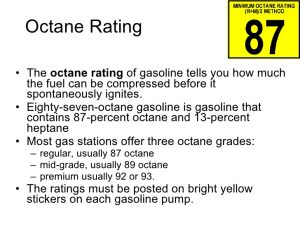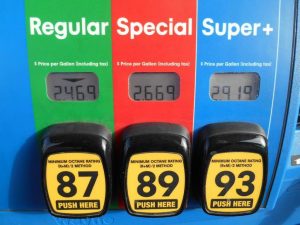Here’s the latest reader question, along with my reply!
Jeremy asks: My 1st Gen Volt requires premium fuel which, in Santa Fe, is usually 50 – 60 cents more per gallon than regular. Is it possible, or advisable, to add an inexpensive octane booster to a tank of regular gas to achieve the higher octane level? How much booster is needed, per gallon of gas, to raise the octane from 87 to 91? Is the Gumout brand any good? Wally World sells a 10 oz. bottle for $2.94. Depending on how much I need to use, this could significantly lower my fill up costs?
My reply: I wouldn’t bother with any of this; here’s why:
While it is true an engine designed to operate at peak efficiency using high octane gas will not return the best possible power (and mileage) on lower octane fuel, you will not hurt the engine by not using lower octane regular fuel as all modern engines have knock sensors and the ECU (the engine’s computer) will adjust such parameters as ignition timing and (if applicable) turbo boost to compensate.
Before modern engine management controls, using lower octane fuel in an engine designed to burn higher octane fuel could result in premature or uncontrolled combustion – and that could hurt the engine.
Basically, what happens is the fuel ignites spontaneously – before the spark plug fires and before the piston reaches the end of its upward travel – due to the heat and pressure inside the combustion chamber resulting from high compression or turbo-supercharging (which pressurizes the air/fuel mix).
The resultant uncontrolled explosion applied tremendous downward force on the piston while it was still traveling up; not good! The “knock” you often heard was a kind of death rattle.
Octane is just a measure of a fuel’s resistance to heat and pressure – to spontaneous combustion. Lower octane fuel is less resistant; higher octane more so.
In a standard (non-hybrid) or even a conventional hybrid, it generally does not make sense to not use the specified octane – not because you may damage the engine but because you will suffer a loss of power/mileage as the engine’s ECU dials back spark and so on to compensate. It’s not a huge difference but it can be enough of a difference – in terms of reduced gas mileage – to negate the cost savings at the pump of using regular.
But the Volt is a unique vehicle, as you know. The gas engine serves primarily as a small generator to make electricity for the electric motor and to keep the battery charged. The car can also be plugged in to recharge and – as you know – has a range of about 50 miles on a full charge, which means if you don’t drive much farther you may not burn any gas at all or not much.
Many Volt owners go weeks or even months without refueling because the car uses so little gasoline.
So – while it is true your Volt’s engine may use a little more gas if you feed it regular unleaded gas, the fact that the car uses so little gas probably means the cost of buying the higher-octane premium is not going to be offset by any meaningful/noticeable range difference since the Volt functions primarily as an electric car unless you regularly drive it significantly farther than its 50-ish miles of range on a full charge, in which case you probably will want to use higher-octane premium to get the maximum efficiency out of the gas engine.
I’m dubious, incidentally, about the value of octane booster vs. just filling up with high-octane premium. In the case of the Volt especially. Ten gallons of premium – which would probably last you a month – costs about $5 more than a tankful of regular, assuming a price difference of about 50 cents per gallon. The octane booster is going to cost you nearly the same and who knows whether it really brings the octane of the 10 gallons you just pumped in up to the same octane level as the premium you skipped. It may also have additives that your fuel system doesn’t like.
Who knows, being my point.
Meanwhile, you know the premium has the specified octane and the additives it contains aren’t going to cause any issues.
Circling back, I’d try a simple experiment: Buy a tank of regular unleaded and drive the Volt as you normally do until you need to refill. Note the mileage/range. Then refill with premium and do the same. Compare the difference and see whether it’s worth the difference in cost to buy the premium or the regular.
My bet is that provided most of your driving falls within the 50-ish miles of the Volt’s battery range, you will notice hardly any difference at all.
Keep us posted on this!
. . .
Got a question about cars, Libertarian politics – or anything else? Click on the “ask Eric” link and send ’em in!
If you like what you’ve found here please consider supporting EPautos.
We depend on you to keep the wheels turning!
Our donate button is here.
If you prefer not to use PayPal, our mailing address is:
EPautos
721 Hummingbird Lane SE
Copper Hill, VA 24079
PS: Get an EPautos magnet or sticker or coaster in return for a $20 or more one-time donation or a $10 or more monthly recurring donation. (Please be sure to tell us you want a magnet or sticker or coaster – and also, provide an address, so we know where to mail the thing!)
My eBook about car buying (new and used) is also available for your favorite price – free! Click here. If that fails, email me at EPeters952@yahoo.com and I will send you a copy directly!











I used to run a custom built engine with 11.5/1 compression ratio. I depended on 93 octane(105 had been gone for some time)and a load of Moroso octane booster. One day when I bought a gallon it had warnings all over it about being a cancer causing agent. I brought my timing down and used 93 octane alone. These days I’d use FI and a computer and let it sort the knock out.
Hey eric, ever since I got a winders tin computer I’ve had to manually put in my moniker and email. Is this common?
Thanks Eric,
Good advice. I’ll do a controlled mileage test, round trip to ABQ (120 miles). Once on regular, once on premium. The hold mode feature on the Volt kicks on the ICE, which provides the juice for the motor, instead of the battery. Assuming that the “gallons used” display is reasonably accurate, I should be able to do a precise enough comparison to see if it makes sense to use premium or regular.
Cheers,
Jeremy